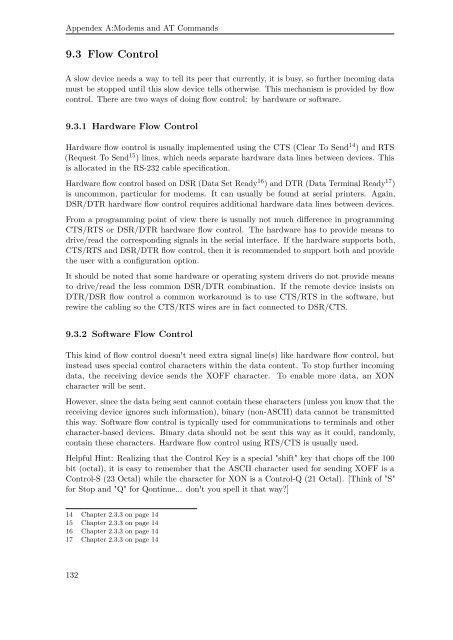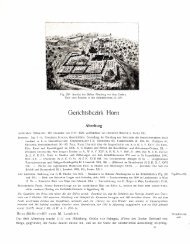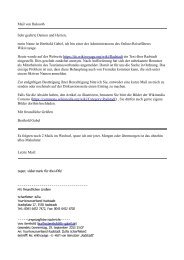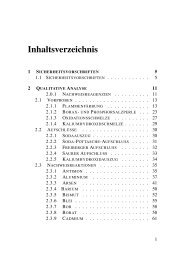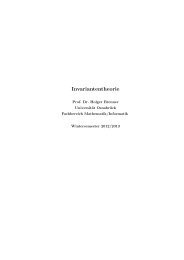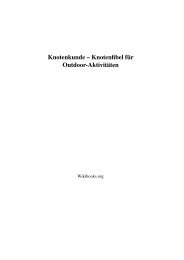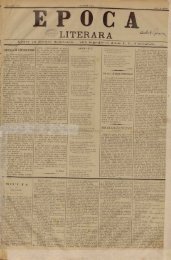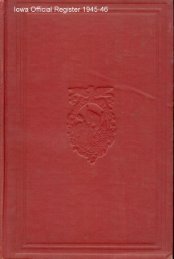Serial Programming - upload.wikimedia....
Serial Programming - upload.wikimedia....
Serial Programming - upload.wikimedia....
You also want an ePaper? Increase the reach of your titles
YUMPU automatically turns print PDFs into web optimized ePapers that Google loves.
Appendex A:Modems and AT Commands<br />
9.3 Flow Control<br />
A slow device needs a way to tell its peer that currently, it is busy, so further incoming data<br />
must be stopped until this slow device tells otherwise. This mechanism is provided by flow<br />
control. There are two ways of doing flow control: by hardware or software.<br />
9.3.1 Hardware Flow Control<br />
Hardware flow control is usually implemented using the CTS (Clear To Send 14 ) and RTS<br />
(Request To Send 15 ) lines, which needs separate hardware data lines between devices. This<br />
is allocated in the RS-232 cable specification.<br />
Hardware flow control based on DSR (Data Set Ready 16 ) and DTR (Data Terminal Ready 17 )<br />
is uncommon, particular for modems. It can usually be found at serial printers. Again,<br />
DSR/DTR hardware flow control requires additional hardware data lines between devices.<br />
From a programming point of view there is usually not much difference in programming<br />
CTS/RTS or DSR/DTR hardware flow control. The hardware has to provide means to<br />
drive/read the corresponding signals in the serial interface. If the hardware supports both,<br />
CTS/RTS and DSR/DTR flow control, then it is recommended to support both and provide<br />
the user with a configuration option.<br />
It should be noted that some hardware or operating system drivers do not provide means<br />
to drive/read the less common DSR/DTR combination. If the remote device insists on<br />
DTR/DSR flow control a common workaround is to use CTS/RTS in the software, but<br />
rewire the cabling so the CTS/RTS wires are in fact connected to DSR/CTS.<br />
9.3.2 Software Flow Control<br />
This kind of flow control doesn't need extra signal line(s) like hardware flow control, but<br />
instead uses special control characters within the data content. To stop further incoming<br />
data, the receiving device sends the XOFF character. To enable more data, an XON<br />
character will be sent.<br />
However, since the data being sent cannot contain these characters (unless you know that the<br />
receiving device ignores such information), binary (non-ASCII) data cannot be transmitted<br />
this way. Software flow control is typically used for communications to terminals and other<br />
character-based devices. Binary data should not be sent this way as it could, randomly,<br />
contain these characters. Hardware flow control using RTS/CTS is usually used.<br />
Helpful Hint: Realizing that the Control Key is a special "shift" key that chops off the 100<br />
bit (octal), it is easy to remember that the ASCII character used for sending XOFF is a<br />
Control-S (23 Octal) while the character for XON is a Control-Q (21 Octal). [Think of "S"<br />
for Stop and "Q" for Qontinue... don't you spell it that way?]<br />
14 Chapter 2.3.3 on page 14<br />
15 Chapter 2.3.3 on page 14<br />
16 Chapter 2.3.3 on page 14<br />
17 Chapter 2.3.3 on page 14<br />
132


